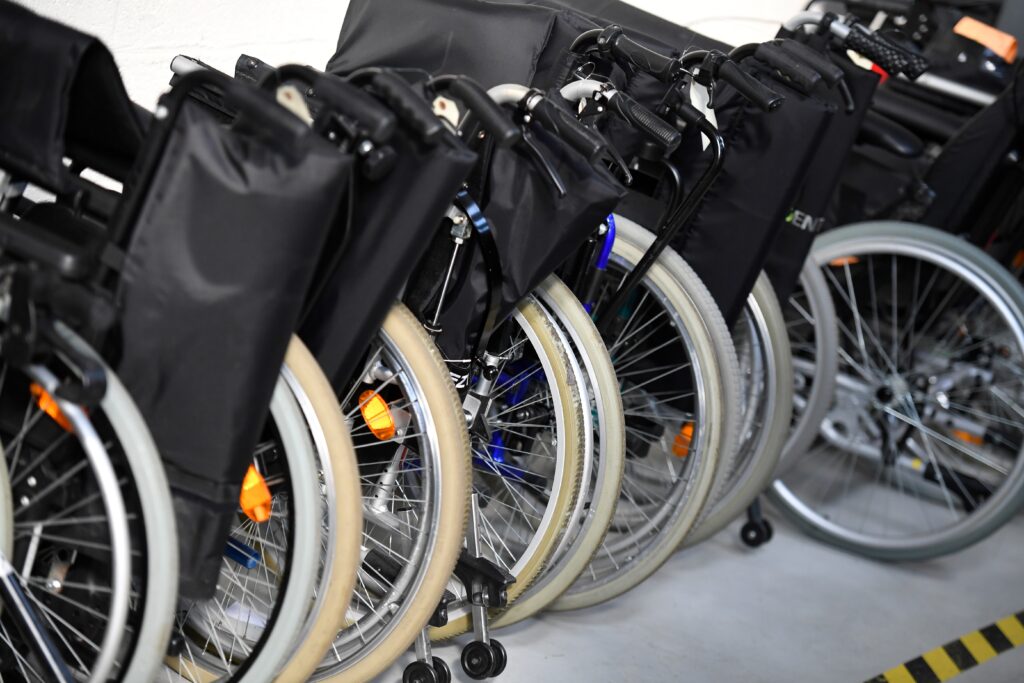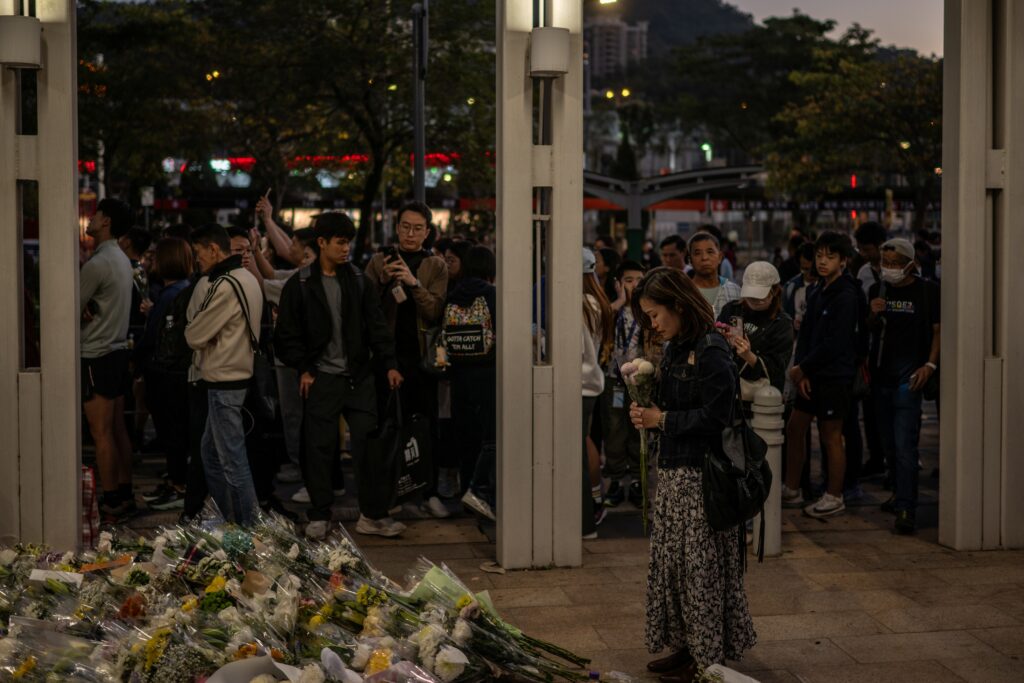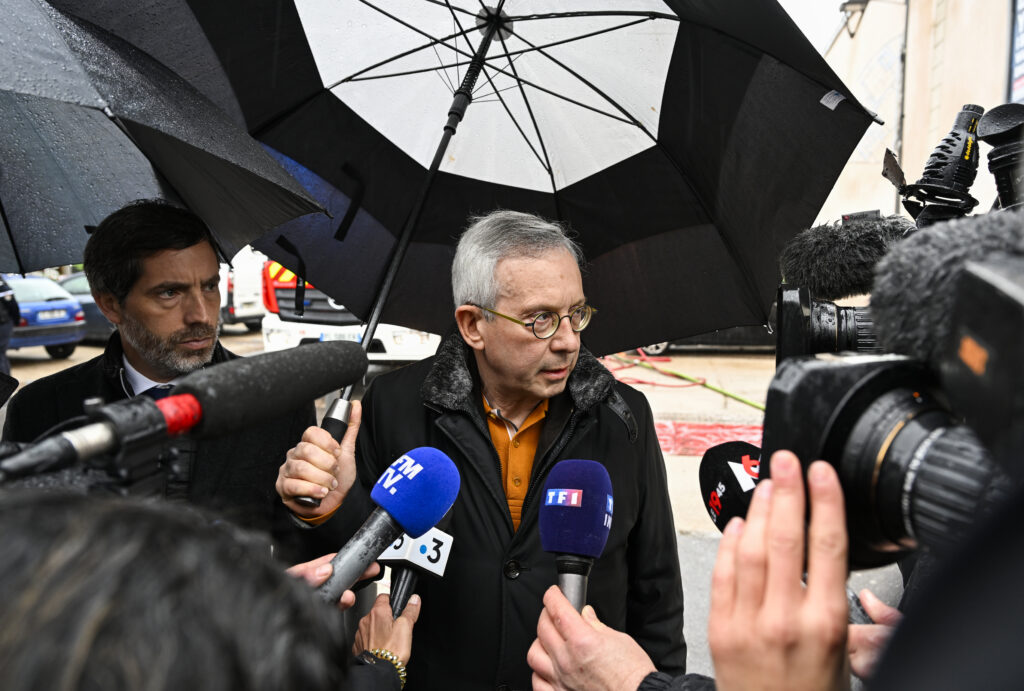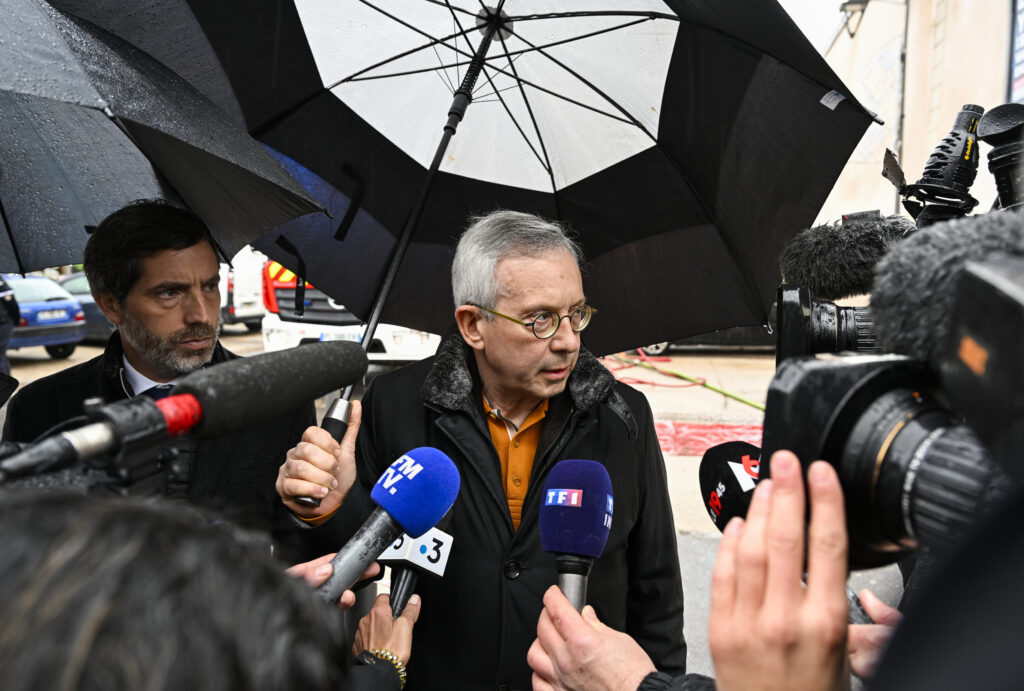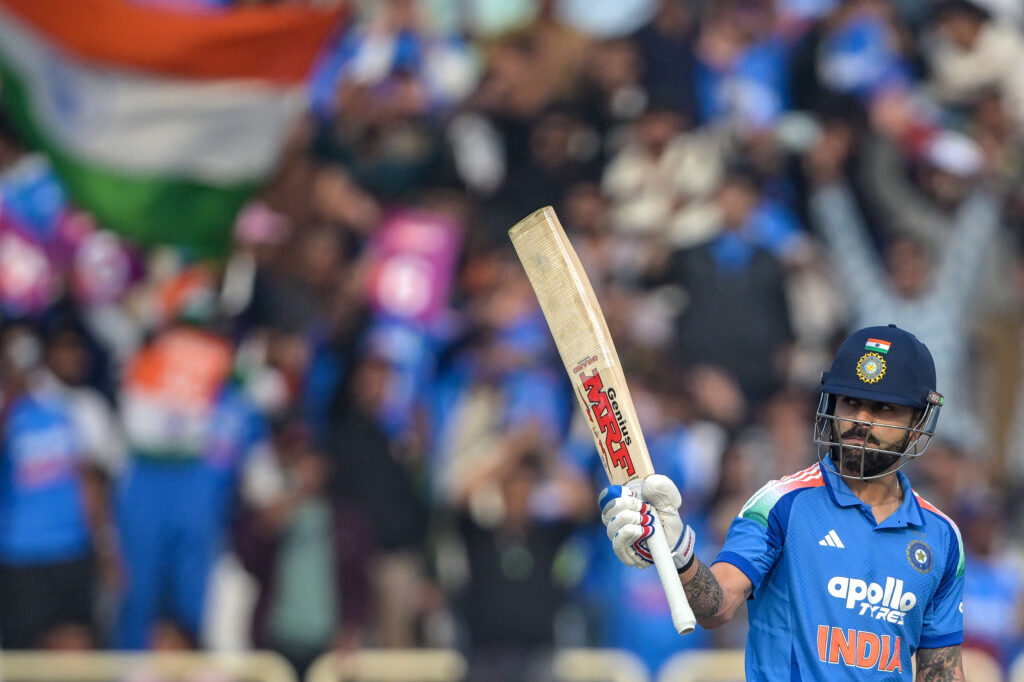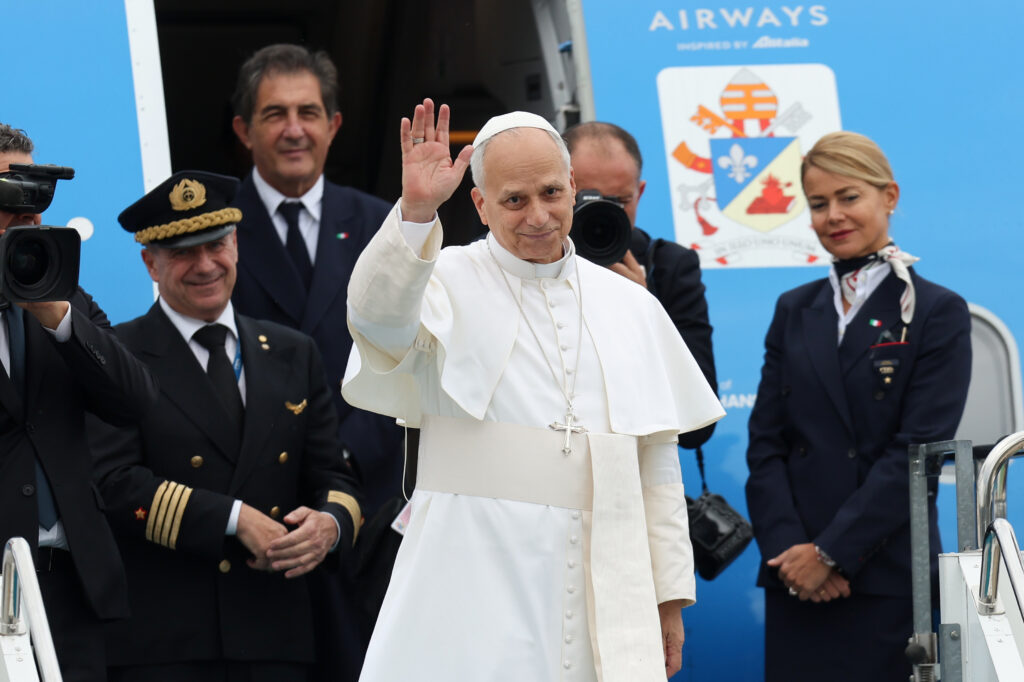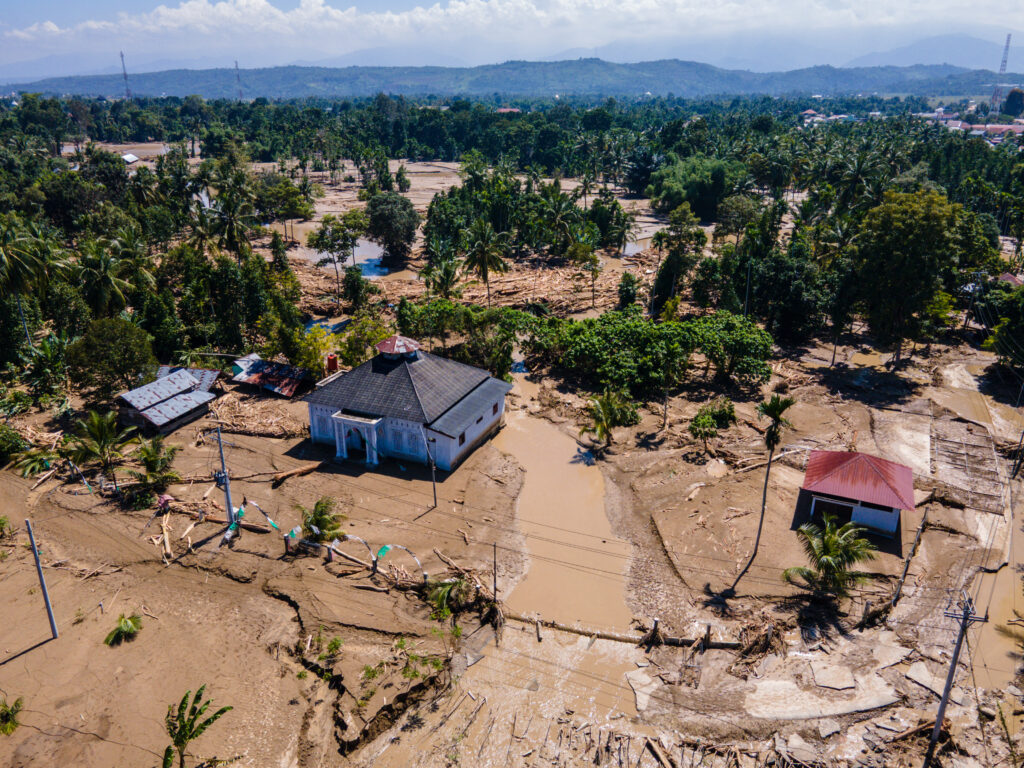Personnes âgées et handicapées: les fauteuils roulants intégralement remboursés à partir de lundi
Promesse du président Macron, les fauteuils roulants seront intégralement remboursés par la Sécurité sociale à partir de lundi pour les personnes handicapées et âgées en perte d’autonomie, avec des procédures rapides et simplifiées.”L’Assurance maladie prendra en charge l’intégralité du financement des fauteuils roulants adaptés aux besoins spécifiques de chacun”, qu’ils soient “liés à un handicap de naissance, acquis au cours de la vie, un accident de la vie” ou une perte d’autonomie liée à l’âge, indique-t-on à l’Élysée.Annoncée par Emmanuel Macron en avril 2023 lors de la Conférence nationale du Handicap, le remboursement par l’Assurance maladie sans reste à charge s’appliquera à “toutes les personnes qui en ont besoin”.Une “première en Europe”, selon l’Élysée, “qui va changer la vie de millions de Françaises et de Français” afin que personne “ne renonce à sa mobilité faute de moyens”.”J’ai besoin de changer mon fauteuil, et je vais pouvoir le changer sans avoir peur du surcoût et de longues démarches”, dit Laurence Devilette, 63 ans, atteinte d’une sclérose en plaque. Acheté 12.000 euros, son fauteuil lui permet de tourner sur elle-même et de se surélever pour atteindre les étagères supérieures dans les supermarchés.Quelque 1,1 million de personnes utilisent un fauteuil roulant et 150.000 personnes en acquièrent un chaque année, selon le ministère des Personnes handicapées.Le gouvernement a négocié ces derniers mois un “cadre tarifaire” avec les fabricants dans une “nomenclature” qui intègre toutes les catégories de fauteuils et qui évoluera avec les progrès techniques.Le remboursement d’un “fauteuil léger classique”, jusqu’ici de 600 euros, passera à 6.000 euros, soit une prise en charge multipliée par dix.Un “fauteuil électrique verticalisateur” pris en charge actuellement à 5.000 euros sera “remboursé à hauteur de 21.000 euros”, indique le ministère des Personnes handicapées sur son site internet.Tous les fauteuils et leurs “options et adjonctions” (bras articulé, fauteuil qui se verticalise…) justifiés par un besoin médical seront remboursés. Avec les options, certains fauteuils peuvent coûter “jusqu’à 100.000 euros”, selon l’Elysée.À la différence du +100% santé+ qui donne accès à des lunettes et dispositifs auditifs sans reste à charge, il ne s’agit pas d’un “panier de produits d’entrée de gamme”: “tous les fauteuils dans toutes les catégories” existant sur le marché sont concernés, explique Malika Boubekeur, conseillère accès aux droits d’APF France Handicap, qui se réjouit de cette “victoire”.- Sans peur du coût -Obtenir un fauteuil relevait jusqu’ici d’un “parcours du combattant qui pouvait prendre plusieurs mois”, explique Pascale Ribes, présidente de l’association.”Il fallait solliciter une mutuelle, puis faire le tour des financeurs: maison départementale des personnes handicapées, collectivités locales, voire ses proches. Certains lançaient même des cagnottes”, explique-t-elle.Désormais la procédure sera rapide et simplifiée, avec un “guichet unique”, l’Assurance maladie. La prescription, effectuée par des professionnels de santé sera adressée à un prestataire de santé à domicile, qui s’occupera des démarches avec l’Assurance Maladie. Le bénéficiaire recevra son fauteuil sans avoir avancé les frais et sans reste à charge.Des options et accessoires spécifiques pourront faire l’objet d’une demande d’entente préalable, mais une non-réponse de l’Assurance maladie vaudra désormais accord, alors qu’avant silence valait refus.Le délai de renouvellement est de cinq ans pour les adultes et trois ans pour les mineurs, plus souvent si les besoins changent: évolution du handicap, de la taille ou la corpulence, selon cette réforme “coconstruite avec les associations”, comme l’AFM Téléthon, APF France Handicap et Paralysie cérébrale France.Par ailleurs, les personnes handicapées pourront en outre se faire rembourser un fauteuil sportif à hauteur de 2.400 euros.En plein débat sur le budget de la sécurité sociale, l’exécutif évalue approximativement le coût de cette réforme à 100 à 200 millions supplémentaires aux 300 millions d’euros consacrés actuellement par an. “Les gens ne prenaient pas les fauteuils adaptés à leurs besoins à cause du reste à charge. Or le fauteuil, c’est le prolongement du corps, c’est l’autonomie. Aujourd’hui chacun va pouvoir avoir accès au fauteuil qu’il lui faut, sans peur du coût”, se réjouit Pascale Ribes.
Incendie de Hong Kong : 146 morts, un activiste réclamant justice présumé arrêté
Les policiers ont continué dimanche à extraire des corps du complexe résidentiel de Hong Kong ravagé par un incendie qui a fait au moins 146 morts jusqu’alors mais pour lequel la demande publique de justice risque de peiner à se faire entendre.Les médias locaux ont rapporté samedi soir qu’un étudiant de 24 ans, Miles Kwan, à l’origine avec d’autres d’une pétition réclamant des comptes pour le pire incendie qu’ait connu la ville depuis 1948 avait été arrêté. La pétition en ligne, qui avait recueilli plus de 10.000 signatures en moins d’une journée, a été supprimée.L’AFP a essayé à plusieurs reprises de joindre Miles Kwan, vainement.Le Bureau pour la sauvegarde de la sécurité nationale, le bras sécuritaire de Pékin à Hong Kong, avait publié samedi un communiqué affirmant soutenir les autorités locales dans leur action pour réprimer les agissements de ceux qui, selon lui, “se servent du drame pour semer le chaos”, sans désigner de fait précis.Hong Kong, rétrocédé à la Chine par le Royaume-Uni en 1997, a vu le contrôle de Pékin se resserrer avec une loi de sécurité nationale stricte passée en 2020 en réaction aux manifestations pro-démocratie.Quatre jours après le sinistre, Hong Kong a continué à communier dans le recueillement et les policiers ont continué à inspecter les tours calcinées du complexe de Wang Fuk Court, dans le district de Tai Po.- Plus d’un tiers des victimes non identifiées -Ils ont fait dans les appartements, les cages d’escalier, les couloirs et même sur les toits de trois immeubles de nouvelles découvertes macabres, portant de 128 à 146 le nombre de personnes décédées.Les journalistes de l’AFP ont vu les policiers transporter de nouveaux sacs mortuaires hors des décombres.Sur les 146 victimes, 54 ne sont toujours pas identifiées.”Nous ne pouvons pas exclure qu’il y ait davantage de personnes décédées”, a dit devant la presse un représentant de la police, Tsang Shuk-yin.Le sinistre s’est déclaré mercredi après-midi, pour des raisons encore inconnues, dans cet ensemble de 1.984 logements et huit tours de 31 étages dans le nord de la ville. Le complexe, inauguré en 1983, était en cours de rénovation, mais toujours habité.Les flammes se sont propagées à grande vitesse, apparemment favorisées par l’emploi de matériaux inflammables pour la rénovation et l’usage, commun à Hong Kong, de bambou plutôt que de métal pour les échafaudages.Les pompiers ont confirmé les dires de nombreux survivants selon lesquels les alarmes n’avaient pas fonctionné.C’est l’incendie d’immeuble le plus meurtrier depuis 1980 dans le monde, à l’exclusion de feux survenus dans des nightclubs, des prisons ou des centres commerciaux, d’après des recherches dans la base de données des catastrophes de l’Université de Louvain en Belgique.- Deuxième jour de deuil -Hong Kong a observé une deuxième journée de deuil. Comme la veille, les anonymes ont formé une file de plus d’un kilomètre pour venir déposer des fleurs ou prononcer une prière à l’emplacement prévu à cet effet au pied des tours.Des centaines d’Indonésiens et de Philippins, nombreux dans le territoire, ont organisé leur hommage ailleurs dans la ville.Le consulat d’Indonésie a indiqué que sept ressortissants avaient péri dans l’incendie. Celui des Philippines a rapporté un décès.Sur les dizaines de blessés, 14 sont dans un état critique, selon les autorités hospitalières.Une commission avait annoncé vendredi soir l’arrestation de huit personnes pour des faits présumés de corruption sur le marché de rénovation: deux responsables du bureau d’études en charge de la rénovation, deux chefs de travaux, trois sous-traitants en échafaudages et un intermédiaire.Samedi, elle a annoncé trois nouvelles arrestations d’individus de 52 à 68 ans, qui avaient déjà interpellés par la police, puis relâchés.
Cinq morts, dont trois jeunes, dans un incendie en Meurthe-et-Moselle
Cinq personnes, dont trois jeunes, sont mortes dimanche dans un incendie à Neuves-Maisons (Meurthe-et-Moselle), une commune située au sud-ouest de Nancy, et une personne a pu en réchapper en se réfugiant sur le toit.Les victimes sont “deux personnes entre 50 et 60 ans et trois autres jeunes personnes”, a détaillé sur place le préfet Yves Séguy.Le seul rescapé a réussi à “prendre place sur le toit de l’immeuble” et a pu “donner l’alerte”. Cette personne est “simplement blessée”, victime d’inhalation de fumées.Les victimes sont “trois personnes d’une même famille, une personne d’une famille un peu éloignée et une amie de la famille”, a précisé à l’AFP Pascal Schneider, le maire de Neuves-Maisons, qui les connaissait de vue. “Un membre de la famille s’en est sorti miraculeusement en s’échappant par les toits”.- “Du mal à y croire” -“On a du mal à y croire”, a confié l’édile. “C’est affreux, que cinq personnes puissent décéder accidentellement dans un incendie aussi violent”Sur le réseau social X, le ministre de l’Intérieur Laurent Nuñez a évoqué “un dramatique incendie” qui a “ravagé cette nuit à Neuves-Maisons, en Meurthe-et-Moselle, une habitation du centre-ville. 5 personnes sont décédées et une autre est blessée. Mes sincères pensées vont aux victimes et à leurs proches”.Le ministre a salué “la mobilisation des sapeurs-pompiers qui ont combattu l’incendie avec courage et celle des gendarmes engagés sur les lieux”.Les pompiers ont été alertés vers 03h15 dimanche de l’incendie survenu rue du Capitaine Caillon dans le centre de Neuves-Maisons, une commune de 7.000 habitants située au sud-ouest de Nancy.Le sinistre a touché un bâtiment de trois niveaux comprenant un magasin au rez-de-chaussée. “Mes premières pensées vont aux victimes et à leurs proches, c’est un dramatique incendie”, a déclaré le préfet Yves Séguy.”A l’heure où nous parlons c’est difficile d’en déterminer les circonstances”, a-t-il ajouté, soulignant qu’une enquête judiciaire “est en cours pour établir dans quelles conditions cet incendie a pu se développer aussi vite et produire autant de dégâts”.”L’immeuble semble en bon état”, a noté le préfet. Il “était occupé simplement par une famille”.La famille “accueillait, semble-t-il, un ou deux adolescents au moment où s’est produit le sinistre”.Les pompiers sont intervenus “en moins d’un quart d’heure, 12 minutes” selon le préfet, “ce qui est peu mais malheureusement ce qui était insuffisant pour arriver à sauver toutes les victimes”.- “De bonnes personnes” -“La famille semblait occuper le dernier étage de cet immeuble et a été victime notamment des fumées”.”C’était des bons vivants, c’était des bonnes personnes”, a déclaré un homme à des journalistes après avoir déposé des roses blanches sur place en hommage aux victimes.Au total, 70 pompiers sont intervenus avec une trentaine de véhicules. Ils ont indiqué être parvenus à maitriser le feu “assez rapidement”.Une vingtaine de gendarmes, dont des membres de la brigade de recherches et du PSIG (peloton de surveillance et d’intervention de la gendarmerie) se sont rendus sur place et trois ambulances ont été utilisées, a précisé la préfecture à l’AFP.L’incendie ne s’est pas propagé aux bâtiments voisins.La mairie a ouvert une cellule d’urgence médico-psychologique destinée en particulier à accueillir et à écouter les proches des victimes.
Cinq morts, dont trois jeunes, dans un incendie en Meurthe-et-Moselle
Cinq personnes, dont trois jeunes, sont mortes dimanche dans un incendie à Neuves-Maisons (Meurthe-et-Moselle), une commune située au sud-ouest de Nancy, et une personne a pu en réchapper en se réfugiant sur le toit.Les victimes sont “deux personnes entre 50 et 60 ans et trois autres jeunes personnes”, a détaillé sur place le préfet Yves Séguy.Le seul rescapé a réussi à “prendre place sur le toit de l’immeuble” et a pu “donner l’alerte”. Cette personne est “simplement blessée”, victime d’inhalation de fumées.Les victimes sont “trois personnes d’une même famille, une personne d’une famille un peu éloignée et une amie de la famille”, a précisé à l’AFP Pascal Schneider, le maire de Neuves-Maisons, qui les connaissait de vue. “Un membre de la famille s’en est sorti miraculeusement en s’échappant par les toits”.- “Du mal à y croire” -“On a du mal à y croire”, a confié l’édile. “C’est affreux, que cinq personnes puissent décéder accidentellement dans un incendie aussi violent”Sur le réseau social X, le ministre de l’Intérieur Laurent Nuñez a évoqué “un dramatique incendie” qui a “ravagé cette nuit à Neuves-Maisons, en Meurthe-et-Moselle, une habitation du centre-ville. 5 personnes sont décédées et une autre est blessée. Mes sincères pensées vont aux victimes et à leurs proches”.Le ministre a salué “la mobilisation des sapeurs-pompiers qui ont combattu l’incendie avec courage et celle des gendarmes engagés sur les lieux”.Les pompiers ont été alertés vers 03h15 dimanche de l’incendie survenu rue du Capitaine Caillon dans le centre de Neuves-Maisons, une commune de 7.000 habitants située au sud-ouest de Nancy.Le sinistre a touché un bâtiment de trois niveaux comprenant un magasin au rez-de-chaussée. “Mes premières pensées vont aux victimes et à leurs proches, c’est un dramatique incendie”, a déclaré le préfet Yves Séguy.”A l’heure où nous parlons c’est difficile d’en déterminer les circonstances”, a-t-il ajouté, soulignant qu’une enquête judiciaire “est en cours pour établir dans quelles conditions cet incendie a pu se développer aussi vite et produire autant de dégâts”.”L’immeuble semble en bon état”, a noté le préfet. Il “était occupé simplement par une famille”.La famille “accueillait, semble-t-il, un ou deux adolescents au moment où s’est produit le sinistre”.Les pompiers sont intervenus “en moins d’un quart d’heure, 12 minutes” selon le préfet, “ce qui est peu mais malheureusement ce qui était insuffisant pour arriver à sauver toutes les victimes”.- “De bonnes personnes” -“La famille semblait occuper le dernier étage de cet immeuble et a été victime notamment des fumées”.”C’était des bons vivants, c’était des bonnes personnes”, a déclaré un homme à des journalistes après avoir déposé des roses blanches sur place en hommage aux victimes.Au total, 70 pompiers sont intervenus avec une trentaine de véhicules. Ils ont indiqué être parvenus à maitriser le feu “assez rapidement”.Une vingtaine de gendarmes, dont des membres de la brigade de recherches et du PSIG (peloton de surveillance et d’intervention de la gendarmerie) se sont rendus sur place et trois ambulances ont été utilisées, a précisé la préfecture à l’AFP.L’incendie ne s’est pas propagé aux bâtiments voisins.La mairie a ouvert une cellule d’urgence médico-psychologique destinée en particulier à accueillir et à écouter les proches des victimes.
Kohli’s 135 powers India to 349-8 in first South Africa ODI
Star batsman Virat Kohli struck an attacking 135 to power India to 349-8 against South Africa in the first of three one-day internationals on Sunday.Kohli’s 120-ball knock and his 136-run stand for the second wicket with fellow stalwart Rohit Sharma (57) steered India to a challenging total in Ranchi.The 37-year-old struck a boundary off Marco Jansen to raise his 52nd ODI century and lifted his bat to a raucous home crowd.An Indian fan breached security and raced to the pitch to touch Kohli’s feet before he was dragged away.Kohli has the most ODI hundreds, with Indian great Sachin Tendulkar second with 49.He and 38-year-old Rohit returned to the ODI team after retiring from T20 and Test cricket.Their presence boosted India, led by KL Rahul in the absence of the injured Shubman Gill, after a 2-0 Test whitewash against South Africa.Rohit lost fellow opener Yashasvi Jaiswal early for 18 but Kohli walked in to a huge roar from a 38,000-strong capacity crowd.They pair steadied the innings and then took on the bowlers before Rohit was trapped lbw by Jansen.He hit five fours and three sixes in his 51-ball knock.India lost a couple more wickets but Kohli stood firm, even though South Africa put the brakes on the scoring in the middle overs.Kohli switched gears soon after reaching his first hundred since February and hit off-spinner Prenelan Subrayen for two fours and two sixes in a 21-run 39th over.He finally fell to Nandre Burger, caught by Ryan Rickelton, after hitting 11 fours and seven sixes.Rahul kept up the attack with 60 off 56 balls, while Ravindra Jadeja made 32 off 20.Aiden Markram is standing in as captain after Temba Bavuma was rested in the opener.
Le pape en vol vers le Liban avec un message de paix
Léon XIV a quitté Istanbul pour Beyrouth dimanche afin de porter un message de paix au Liban éprouvé par une crise endémique et une guerre meurtrière avec Israël, après une visite en Turquie marquée par le dialogue pour l’unité des chrétiens.Le pape américain a décollé peu avant 15H00 (12H00 GMT) et devrait arriver vers 15H45 (13H45 GMT) à l’aéroport de Beyrouth, pour une visite de 48 heures dans ce pays multiconfessionnel de 5,8 millions d’habitants.Longtemps érigé en modèle de coexistence, le Liban est englué depuis 2019 dans une crise dévastatrice: effondrement monétaire, appauvrissement généralisé, services publics défaillants, explosion du port de Beyrouth en 2020 et guerre avec Israël.En dépit du rôle politique important que jouent les chrétiens au Liban, seul État arabe où le poste de président de la République est réservé à cette communauté, ces derniers ont vu leur nombre diminuer au cours des dernières décennies, notamment en raison de l’émigration des jeunes.Léon XIV, premier pape à visiter le pays depuis Benoît XVI en 2012, sera reçu dans l’après-midi par le président Joseph Aoun, le Premier ministre Nawaf Salam et le président du Parlement Nabih Berri, avant de prononcer un premier discours devant les autorités et le corps diplomatique à 18H00 (16H00 GMT).Samedi, le Hezbollah a exhorté le pape à rejeter “l’injustice et l’agression” d’Israël contre le Liban, après avoir essuyé le 23 novembre une frappe israélienne qui a tué son chef militaire.Malgré le cessez-le-feu intervenu il y a un an, l’armée israélienne a intensifié ces dernières semaines ses frappes au Liban, en majorité dans le sud, disant viser le mouvement pro-iranien alors que l’armée libanaise s’est engagée à le désarmer.- Arméniens “courageux” -Dimanche matin, il a clôturé sa visite en Turquie, la première dans un pays étranger depuis son élection en mai, avec une cérémonie liturgique très solennelle sous les dorures de la cathédrale orthodoxe Saint-Georges d’Istanbul, entre icônes, volutes d’encens et chants polyphoniques psalmodiés.”En cette période de conflits sanglants et de violences, dans des lieux proches et lointains, les catholiques et les orthodoxes sont appelés à être des constructeurs de paix”, a-t-il déclaré.Peu avant, à la cathédrale arménienne d’Istanbul, il a loué “le courageux témoignage chrétien du peuple arménien au cours des siècles, souvent lors de circonstances tragiques”.Une manière d’évoquer sans la nommer la question très sensible du génocide arménien, alors qu’Ankara réfute avec virulence cette qualification des massacres de 1915-1916 sous l’empire ottoman.Pour Mardik Evadian, homme d’affaires arménien présent à la cathédrale, “aujourd’hui, il n’est pas important de parler de génocide ou non”. “C’est une histoire ancienne. Nous avons connu des pertes humaines, des familles entières, mais nous vivons dans ce pays et nous sommes heureux d’y vivre. Il y a peut-être eu des problèmes par le passé, mais aujourd’hui, c’est la paix”, a-t-il confié.En Turquie, Léon XIV a reçu un accueil chaleureux de la part de la petite communauté catholique, mais sa visite est restée discrète, notamment en raison d’un lourd dispositif de sécurité qui a empêché tout contact avec l’extérieur.Il a cependant pris le temps de rencontrer en privé le père de Mattia Ahmet Minguzzi, 14 ans, tué en janvier dernier lors d’une agression dans un quartier populaire d’Istanbul qui avait choqué la Turquie.- Jours fériés -Pour son premier voyage à l’étranger, Léon XIV a affiché son style prudent depuis son élection, ménageant les sensibilités politiques de ses interlocuteurs tout en répétant ses messages en faveur de l’unité et du respect de la diversité religieuse.Il s’envole pour Beyrouth à bord d’un A320 de la compagnie italienne ITA qui a été réparé samedi en raison d’un logiciel de commandes vulnérable, comme des milliers d’autres dans le monde.Pour se rendre au palais présidentiel, il devra traverser la banlieue sud de Beyrouth, bastion du Hezbollah, où les portraits de son chef assassiné par Israël côtoient des panneaux souhaitant la bienvenue au souverain pontife.Les scouts du Hezbollah se préparent à accueillir le pape sur cette route, avec une fanfare, a annoncé leur chaine Al-Manar. La banlieue sud de Beyrouth avait été visée par la frappe israélienne qui a tué le nouveau chef militaire du Hezbollah.”Le choix du Liban est un choix courageux”, a déclaré Mgr Hugues de Woillemont, président de l’Oeuvre d’Orient, une organisation catholique qui vient en aide aux chrétiens d’Orient.”Le modèle multiconfessionnel du Liban est aujourd’hui extrêmement fragilisé par des logiques d’affrontement, même si le pays a aujourd’hui à sa tête un président et un Premier ministre qui travaillent ensemble”, a-t-il ajouté.Le Liban a déclaré deux jours fériés pour la visite et d’importantes mesures de sécurité ont été mises en place, avec des routes fermées, l’interdiction de drones et l’évacuation de larges portions du centre-ville lundi soir, avant la messe.
Les inondations en Indonésie, Thaïlande et Sri Lanka dépassent les 800 morts
Le bilan des inondations catastrophiques qui ont frappé ces derniers jours de vastes territoires d’Indonésie, de Thaïlande, de Malaisie et du Sri Lanka s’est encore alourdi dimanche, avec un total d’au moins 818 morts et plusieurs centaines de disparus. Les autorités de ces pays asiatiques s’activaient pour dégager les routes et les débris et tenter de retrouver des personnes portées disparues après des pluies diluviennes, des crues subites et des glissements de terrain.En Asie du Sud-Est, l’Indonésie, pays de loin le plus touché, déplore au moins 442 morts tandis que 402 personnes sont toujours portées disparues, selon un dernier bilan de l’agence de gestion des catastrophes.En Thaïlande, où au moins 162 habitants ont péri dans l’une des pires inondations de la décennie, les autorités continuaient de distribuer de l’aide à des dizaines de milliers de sinistrés sans abri et réparer les dégâts.En Malaisie, les inondations qui ont submergé de larges zones de l’Etat septentrional de Perlis ont fait deux morts.En Asie du Sud, le Centre de gestion des catastrophes (DMC) du Sri Lanka a indiqué dimanche qu’au moins 212 personnes avaient perdu la vie après une semaine de fortes pluies provoquées par le cyclone Ditwah, tandis que 218 autres étaient toujours portées disparues. – Navires de guerre -En Indonésie, au moins deux villes de l’île de Sumatra, la plus touchée du pays, étaient encore inaccessibles dimanche, et les autorités ont annoncé avoir déployé deux navires de guerre depuis Jakarta pour livrer de l’aide. “Deux villes nécessitent une attention particulière en raison de leur isolement, à savoir Tapanuli Central et Sibolga”, a déclaré Suharyanto, chef de l’agence nationale de gestion des catastrophes, dans un communiqué, ajoutant que les navires de guerre étaient attendus à Sibolga lundi.Dans le village de Sungai Nyalo, à environ 100 km de la capitale de Sumatra Ouest, Padang, les eaux de crue avaient en grande partie reflué dimanche, laissant des maisons, des véhicules et des cultures recouverts d’une épaisse boue grise. Les autorités n’avaient pas encore commencé à dégager les routes, ont indiqué des habitants à l’AFP, et aucune aide extérieure n’était arrivée. “La plupart des villageois ont choisi de rester; ils ne voulaient pas abandonner leurs maisons”, a déclaré Idris, 55 ans, qui, comme beaucoup d’Indonésiens, ne porte qu’un seul nom.En Thaïlande, les autorités continuaient de chercher les nombreux disparus et le gouvernement a mis en place des mesures de secours pour les personnes touchées par les inondations, y compris une compensation pouvant aller jusqu’à deux millions de bahts (53.000 euros) pour les foyers ayant perdu des membres de leur famille. Cependant, les critiques envers la réponse de la Thaïlande aux inondations se sont accrues, et deux responsables locaux ont été suspendus de leurs fonctions.- Privés d’électricité -Au Sri Lanka, alors que Ditwah s’est déporté samedi vers l’Inde, des zones entières du nord de la capitale du Sri Lanka, Colombo, étaient inondées dimanche.”Bien que le cyclone nous ait quittés, de fortes pluies en amont inondent maintenant les zones basses le long des rives de la rivière Kelani”, a déclaré un responsable du DMC.Le président Anura Kumara Dissanayake a déclaré samedi l’état d’urgence, qui lui confère des pouvoirs étendus pour gérer la crise. L’armée a été déployée pour soutenir les secours.”Ma maison est totalement inondée, je ne sais pas où aller, mais j’espère trouver un abri sûr où emmener ma famille”, dit à l’AFP Selvi, une habitante de la banlieue de Colombo de 46 ans, qui transporte quatre sacs d’affaires.Le Sri Lanka a lancé un appel à l’aide internationale pour les quelque 833.000 déplacés, auxquels s’ajoutent 122.000 personnes prises en charge dans des refuges temporaires.Selon les autorités, environ un tiers de la population est toujours privé d’électricité et d’eau courante.Il s’agit de la pire catastrophe naturelle dans le pays depuis 2017, quand des inondations et des glissements de terrain avaient tué plus de 200 personnes.Le changement climatique a affecté les régimes de tempêtes, y compris la durée et l’intensité de des pluies, plus abondantes, avec des crues soudaines et des rafales de vent plus fortes.
Les inondations en Indonésie, Thaïlande et Sri Lanka dépassent les 800 morts
Le bilan des inondations catastrophiques qui ont frappé ces derniers jours de vastes territoires d’Indonésie, de Thaïlande, de Malaisie et du Sri Lanka s’est encore alourdi dimanche, avec un total d’au moins 818 morts et plusieurs centaines de disparus. Les autorités de ces pays asiatiques s’activaient pour dégager les routes et les débris et tenter de retrouver des personnes portées disparues après des pluies diluviennes, des crues subites et des glissements de terrain.En Asie du Sud-Est, l’Indonésie, pays de loin le plus touché, déplore au moins 442 morts tandis que 402 personnes sont toujours portées disparues, selon un dernier bilan de l’agence de gestion des catastrophes.En Thaïlande, où au moins 162 habitants ont péri dans l’une des pires inondations de la décennie, les autorités continuaient de distribuer de l’aide à des dizaines de milliers de sinistrés sans abri et réparer les dégâts.En Malaisie, les inondations qui ont submergé de larges zones de l’Etat septentrional de Perlis ont fait deux morts.En Asie du Sud, le Centre de gestion des catastrophes (DMC) du Sri Lanka a indiqué dimanche qu’au moins 212 personnes avaient perdu la vie après une semaine de fortes pluies provoquées par le cyclone Ditwah, tandis que 218 autres étaient toujours portées disparues. – Navires de guerre -En Indonésie, au moins deux villes de l’île de Sumatra, la plus touchée du pays, étaient encore inaccessibles dimanche, et les autorités ont annoncé avoir déployé deux navires de guerre depuis Jakarta pour livrer de l’aide. “Deux villes nécessitent une attention particulière en raison de leur isolement, à savoir Tapanuli Central et Sibolga”, a déclaré Suharyanto, chef de l’agence nationale de gestion des catastrophes, dans un communiqué, ajoutant que les navires de guerre étaient attendus à Sibolga lundi.Dans le village de Sungai Nyalo, à environ 100 km de la capitale de Sumatra Ouest, Padang, les eaux de crue avaient en grande partie reflué dimanche, laissant des maisons, des véhicules et des cultures recouverts d’une épaisse boue grise. Les autorités n’avaient pas encore commencé à dégager les routes, ont indiqué des habitants à l’AFP, et aucune aide extérieure n’était arrivée. “La plupart des villageois ont choisi de rester; ils ne voulaient pas abandonner leurs maisons”, a déclaré Idris, 55 ans, qui, comme beaucoup d’Indonésiens, ne porte qu’un seul nom.En Thaïlande, les autorités continuaient de chercher les nombreux disparus et le gouvernement a mis en place des mesures de secours pour les personnes touchées par les inondations, y compris une compensation pouvant aller jusqu’à deux millions de bahts (53.000 euros) pour les foyers ayant perdu des membres de leur famille. Cependant, les critiques envers la réponse de la Thaïlande aux inondations se sont accrues, et deux responsables locaux ont été suspendus de leurs fonctions.- Privés d’électricité -Au Sri Lanka, alors que Ditwah s’est déporté samedi vers l’Inde, des zones entières du nord de la capitale du Sri Lanka, Colombo, étaient inondées dimanche.”Bien que le cyclone nous ait quittés, de fortes pluies en amont inondent maintenant les zones basses le long des rives de la rivière Kelani”, a déclaré un responsable du DMC.Le président Anura Kumara Dissanayake a déclaré samedi l’état d’urgence, qui lui confère des pouvoirs étendus pour gérer la crise. L’armée a été déployée pour soutenir les secours.”Ma maison est totalement inondée, je ne sais pas où aller, mais j’espère trouver un abri sûr où emmener ma famille”, dit à l’AFP Selvi, une habitante de la banlieue de Colombo de 46 ans, qui transporte quatre sacs d’affaires.Le Sri Lanka a lancé un appel à l’aide internationale pour les quelque 833.000 déplacés, auxquels s’ajoutent 122.000 personnes prises en charge dans des refuges temporaires.Selon les autorités, environ un tiers de la population est toujours privé d’électricité et d’eau courante.Il s’agit de la pire catastrophe naturelle dans le pays depuis 2017, quand des inondations et des glissements de terrain avaient tué plus de 200 personnes.Le changement climatique a affecté les régimes de tempêtes, y compris la durée et l’intensité de des pluies, plus abondantes, avec des crues soudaines et des rafales de vent plus fortes.

